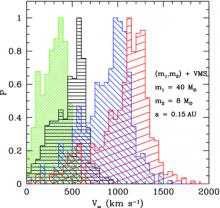
Abstract
We explore the hypothesis that some high-velocity runaway stars attain their peculiar velocities in the course of exchange encounters between hard massive binaries and a very massive star (either an ordinary 50-100 Msun star or a more massive one, formed through runaway mergers of ordinary stars in the core of a young massive star cluster). In this process, one of the binary components becomes gravitationally bound to the very massive star, while the second one is ejected, sometimes with a high speed. We performed three-body scattering experiments and found that early B-type stars (the progenitors of the majority of neutron stars) can be ejected with velocities of >200-400 km/s (typical of pulsars), while 3-4 Msun stars can attain velocities of >300-400 km/s (typical of the bound population of halo late B-type stars). We also found that the ejected stars can occasionally attain velocities exceeding the Milky Way's escape velocity.